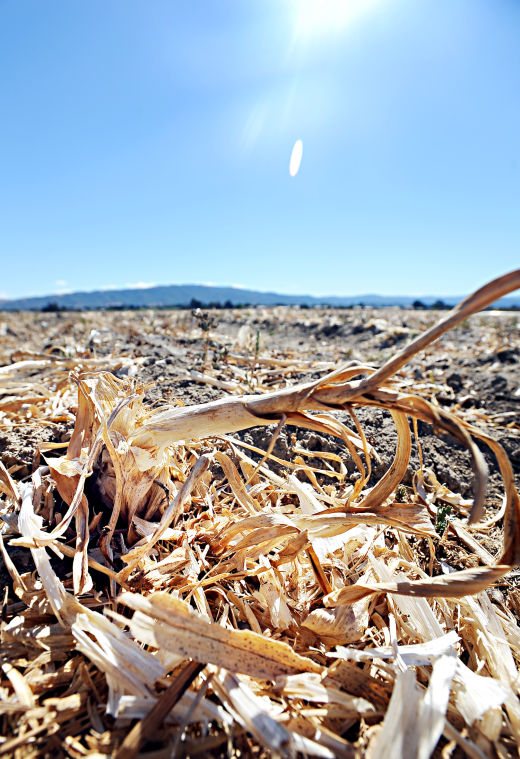
Santa Clara County’s Gilroy may be the garlic capital of the world, but at least three consecutive years of crop reports reveal San Benito County produces more of the stinking rose.
Just last year, San Benito County produced 319 more acres of garlic than the county that’s home to the annual garlic festival, taking place this weekend at Christmas Hill Park in Gilroy.
“I think for years, it was the garlic capital of the world, but then trends change,” said Joe Deviney, the agricultural commissioner for Santa Clara County. “They became famous for garlic at one point in the history and then it caught on in the festival.”
While San Benito County produces more of the stinking bulb these days, Santa Clara County still processes more garlic with two plants handling more than 85 million pounds of garlic each year, sending the pungent smell wafting through the area’s small towns.
Farmers, agricultural commissioners and an agricultural biologist have a variety of explanations for the growers’ movement south including soil properties, the need to rotate crops through multiple fields, the lack of a nasty onion- and garlic-killing fungus called white rot, and the availability of more large tracks of agricultural land in San Benito County.
“I’m not surprised,” said Eric Wylde, the deputy agricultural commissioner for the Santa Clara County Division of Agriculture, as he considered the rising trend of garlic in the Hollister area. “And I know many counties in the Central Valley have more garlic than San Benito does.”
Those valley producers are starting to take notice of this area as well, though. San Benito County Agricultural Biologist Ken Griffin noted many garlic producers who usually grow the crop in the Central Valley are now looking for other places to produce due to the rain shortage.
The valley has long been a popular place to grow the pungent bulb because the soil is light and brushes off easily after the harvest. Light soil means less cleaning costs for growers and also means the precious bulbs are less likely to be bruised by some rough handling, Griffin said.
“In southern San Benito County and some parts of northern, there is a lot of light, light soil,” Griffin said. “But we have a pretty big variety of soil types in San Benito County, whereas Santa Clara doesn’t, which is probably why their numbers (of acres of garlic) are a bit lower.”
Two of the area’s largest garlic producers – Christopher Ranch and George Chiala Farms – rotate garlic production through fields in both counties to allow the soil to recover nutrients.
Tim Chiala – one of six co-owners of the family-run George Chiala Farms – believes the farm’s distribution of garlic crops fits the county trends. This year, the farm is growing about one-third of its garlic crop in Santa Clara County and the other two-thirds in San Benito County.
Appetite for San Benito County
The farm began planting more crops in San Benito County five or six years ago because the area had large tracks of agricultural land available for lease, the light soil was good for growing garlic, and the earth was well suited to the farm’s transition to more machine harvesting, Chiala said.
But Chiala notes that he’s more likely to keep growing organic garlic in San Benito County, where he hasn’t seen a disastrous fungus called white rot, which kills garlic crops.
“There are certain fields in Santa Clara County that have white rot. The white rot is a really bad disease in garlic and onions that wipes out your crop,” Chiala said. “I haven’t seen that in Hollister.”
A representative of Christopher Ranch observed that the company expanded its garlic-growing production south for much the same reason.
“You can test for it but you’d have to test every square inch and that’s not possible, so if you grow in soil that has white rot, all of the sudden a section of the field that has white rot won’t grow,” said Patsy Ross, a marketing director for Christopher Ranch. “That was one of the reasons back in the day we moved a lot of our garlic out of Gilroy.”
But according to Ross and Chiala, the Gilroy area will continue to be famous for its garlic – not because of the acres of the bulb farmed within Santa Clara County limits, but because of the city’s history as the home of garlic processors, which send the smell of the bulb wafting across town.
Each year, the Gilroy-based garlic giant Christopher Ranch processes more than 70 million pounds of garlic from across the state in the garlic capital of the world. The city was once home to two garlic processors, but today there is just one – and of course, the annual Gilroy Garlic Festival. George Chiala Farms has its own processing plant in nearby Morgan Hill, where it handles between 15 million and 20 million pounds of garlic each year.
“That’s a lot of garlic being processed in one region,” Chiala said. “So, I still think it’s legit that it’s still the garlic region of the world.”
MORE GARLIC INFORMATION:
Acres of garlic produced by county and year:
San Benito County in 2014: 627
Santa Clara County in 2014: 432
San Benito County in 2013: 573
Santa Clara County in 2013: 254
San Benito County in 2012: 420
Santa Clara County in 2012: 314
SOURCE: Crop reports for Santa Clara and San Benito County
How much more garlic has San Benito County produced compared with Santa Clara County for the last three years?
2014: 195 more acres of garlic
2013: 319 more acres of garlic
2012: 106 more acres of garlic









